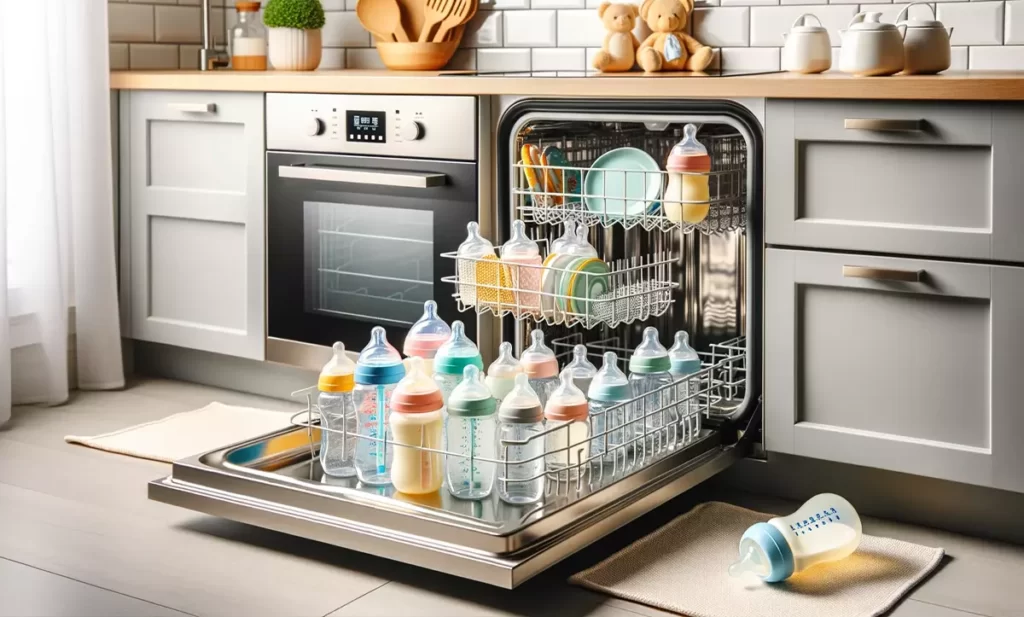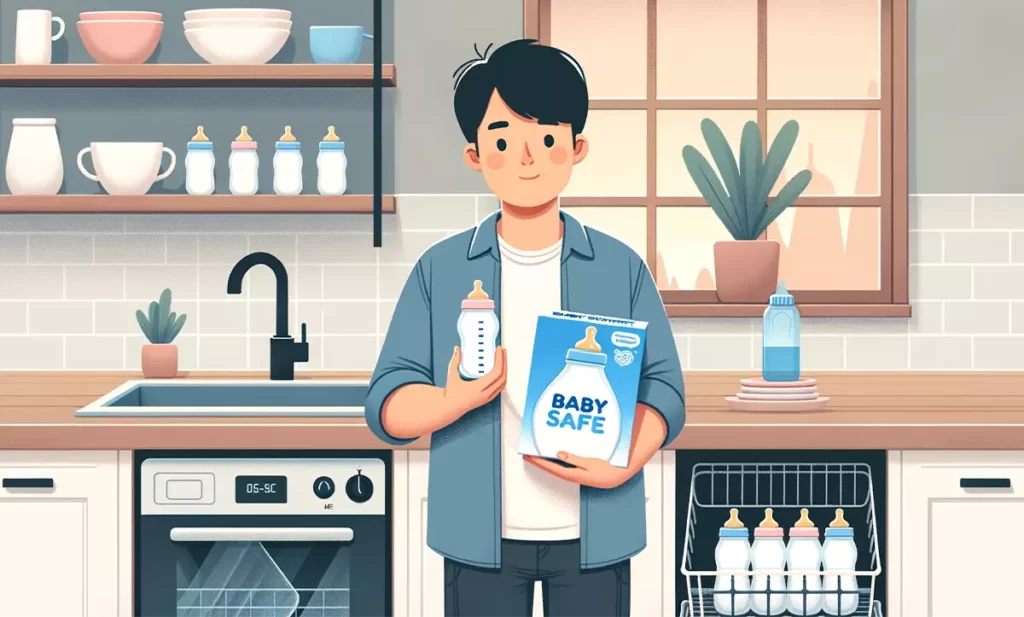It is generally safe to wash baby bottles in the dishwasher as long as you follow proper procedures. The high heat and pressure of a dishwasher cycle can thoroughly clean and sanitize baby bottles and other feeding items.
Taking care of a baby can be challenging. Especially when guaranteeing the cleanliness of feeding bottles can affect the baby’s health. The main topics of this article covered include baby bottle washing steps in the dishwasher, advantages like sanitization and efficiency, detergent considerations like baby-safe, drying thoroughly before reuse, etc.
Also, it discusses what types of bottles are dishwasher-safe, choosing the right detergent, and common mistakes to avoid regarding bottle hygiene.
Overall, the dishwasher is an effective way to clean baby bottles, but specific guidelines should be followed.
Is It Safe to Wash Baby Bottles in the Dishwasher?
Yes, it is safe to wash baby bottles in the dishwasher. Many modern baby bottles are designed to withstand the high temperatures of a dishwasher, ensuring thorough cleaning and sterilization.

The high heat and pressure of a dishwasher can thoroughly clean and sanitize baby bottles and other feeding items. However, it’s essential to check the manufacturer’s instructions for your specific bottles to ensure they are dishwasher-safe.
How to Wash Baby Bottles in the Dishwasher?
Follow these tips for safely washing baby bottles in the dishwasher:
- Step 1: Rinse bottles thoroughly after each use. Do not allow milk or formula to dry on the bottles. Dried-on residue can lead to buildup.
- Step 2: Disassemble the bottles, removing the nipples, rings, and other parts.
- Step 3: Place the bottles upside down on the top rack of the dishwasher. This prevents water from pooling inside the bottles during the wash cycle. Place them, ensuring they are spaced out and not touching each other.
- Step 4: Use a dishwasher basket for smaller parts like nipples, rings, caps, and valves to avoid getting lost.
High heat can cause rubber components to deteriorate over time.
- Step 5: Add dishwasher detergent to both the prewash and main wash compartments. Use a mild dishwasher detergent that’s safe for baby products.
- Step 6: Run the dishwasher on the hottest cycle according to manufacturer instructions, generally around 140°F, to kill germs and ensure thorough cleaning and sterilization.
- Step 7: Once the cycle is complete, remove the bottles and parts, allowing them to air dry completely before reassembling.
What are the Benefits of Using a Dishwasher to Clean Baby Bottles?
Using a dishwasher to clean baby bottles offers several advantages:
- Thorough cleaning: The intense water pressure in dishwashers ensures that bottles are clean and the high temperatures are sterilized, eliminating harmful bacteria.
- Sanitization: The high heat of dishwasher cycles kills 99% of germs and bacteria when reaching proper temperatures. This reduces the risk of illness.
- Efficiency: Dishwashers can clean multiple bottles at once, saving time and effort.
- Convenience: Dishwashers clean with the simple press of a button. There’s no need to hand wash or sterilize bottles.
Can I Wash All Types of Baby Bottles in the Dishwasher?
Most standard plastic and glass baby bottles are dishwasher safe. However, there are some exceptions:
- Silicone bottles: Silicone can become damaged and degraded over time in the dishwasher. Hand wash these bottles instead.
- Antique or handmade glass bottles: Check the manufacturer’s instructions, as some decorative glass bottles may be too delicate for high heat.
- Bottles with electronic components: Bottles with built-in thermometers or timers should not go in the dishwasher. The electronics can get damaged.
When in doubt, hand wash to be safe. Avoid extreme water temperatures and harsh detergents to prevent damaging bottles. It’s crucial to check the manufacturer’s instructions for each bottle type.
Tips for Cleaning Baby Bottles
- Always rinse bottles immediately after use. Do not allow breast milk or formula to dry inside the bottles.
- Use dishwasher baskets or bottle racks to secure bottles during the wash cycle.
- Wash nipples and caps separately from bottles, either by hand or in the dishwasher.
- Scrutinize bottles thoroughly after washing. Discard any bottles with cracks, cloudiness, or worn parts.
- Allow bottles to air dry thoroughly after washing to prevent mold growth. Ensure bottles are completely dry before storing.
- Clean the dishwasher monthly by running a hot cycle with 2 cups of white vinegar to remove odors and residue.
How to Choose the Right Dishwasher Detergent for Baby Bottles?
Look for dishwasher detergents designed specifically for baby items when washing baby bottles. Check if the products are labeled “baby-safe” or “mild.”

Reading reviews and recommendations from other parents can also help make an informed choice. Also, avoid the detergent that includes the following ingredients:
- Chlorine bleach – Can be harsh and leave behind residues
- Phosphates – Can be harmful if ingested
- Dyes – Can discolor bottles
- Strong perfumes – Can leave lingering odors
What Dishwasher Detergent is Safe for Baby Bottles?
Fragrance-free, plant-based dishwasher powders are ideal for baby bottles. They effectively clean bottles without leaving behind chemicals. Powders tend to work better than gels or pods.
Some top options include:
- Seventh Generation Dishwasher Detergent – Hypoallergenic and made from plant enzymes
- Dapple Baby Dishwasher Detergent Pacs – Fragrance-Free and Powered by plants
- Ecover Automatic Dishwasher Detergent – Plant-based with minerals for water softening
- Babyganics Dishwasher Detergent Pods – Fragrance, dye and bleach-free
- Biokleen Automatic Dish Powder – Made from grapefruit seed extract and plant enzymes
Always check that the detergent is specifically labeled as safe for babies, children’s items, or sensitive skin. Avoid anti-bacterial formulas.
Common Mistakes to Avoid When Cleaning Baby Bottles
- Forgetting to disassemble bottles before washing
- Forgetting to rinse bottles immediately after use
- Overloading the dishwasher with too many bottles
- Using the wrong type of dishwasher detergent
- Use regular dish soap, which might leave a residue.
- Not checking that bottles are totally dry before reassembling
- Storing wet bottles – increases the risk of growing mold
- Not replacing worn and damaged bottles
- Not cleaning the dishwasher itself frequently enough
Proper techniques are key to sanitizing baby bottles and preventing health issues entirely. Take care to avoid these mistakes.
Why Is It Important to Clean and Sterilize Baby Bottles?
Cleaning and sterilizing baby bottles are crucial to ensure the health and safety of your baby. Regular cleaning and sterilization eliminate these bacteria, ensuring your baby’s feeding equipment is safe.
Key reasons for bottle hygiene:
- Prevents disease: Kills viruses, bacteria, parasites that cause vomiting, diarrhea, etc.
- Avoids contamination: Removes traces of spoiled milk that could cause stomach issues. Milk and formula residues can grow harmful bacteria, leading to illnesses.
- Limits exposure: Reduces chances of exposing the baby to potential allergens.
- Promotes safety: Careful cleaning keeps plastic from breaking down over time.
Consistent bottle cleaning is vital to infant health, especially for newborns to 3 months old.
How Often Should I Wash Baby Bottles?
Baby bottles should be washed after every use. Do not allow breast milk or formula to dry inside. It’s recommended to sterilize bottles at least once a day, especially for younger infants.
Aside from cleaning bottles after each use:
- Daily: Take apart, clean, and sanitize all bottle parts at the end of each day.
- Every three days: Clean bottles deeply using scrub brushes to remove stains.
- Weekly: Disinfect nipples by boiling for 5 minutes. Replace if frayed.
- Monthly: Wash all bottle brushes and drying racks to prevent bacterial growth.
What Are the Different Ways to Clean and Sterilize Baby Bottles?
- Dishwashing: Use a hot sanitizing cycle and safe dishwasher detergent.
- Steaming: Use a microwave or electric steam sterilizer.
- Boiling: Immerse bottles in boiling water for 5-10 minutes.
- UV light: Shine germicidal UV light inside bottles to kill bacteria.
- Bleach solution: Soak bottles in a weak bleach and water solution. Rinse thoroughly.
- Vinegar wash: Use diluted vinegar to remove residue from bottles.
- Combining methods: Washing in the dishwasher and then steaming provides maximum disinfection. Always inspect bottles closely after cleaning.

James is an organic fertilizer professional who owns a successful organic fertilizer company in new jersey. He is an expert in waste management in both houses and community cases. In his free time, he loves to write about his experiences in the field.

